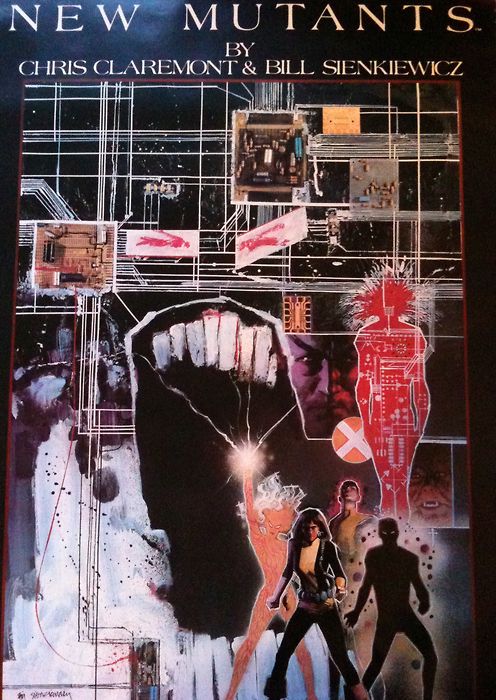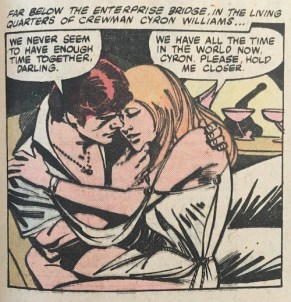
“The Expansionist Syndrome” (22 pages)
Writer: Martin Pasko
Artists: Dave Cockrum & Ricardo Villamonte
Letterer: Ray Burzon
Colorist: Carl Gafford
Editor: Louise Jones
Editor in Chief: Jim Shooter
Cover artist: Dave Cockrum
A few changes this issue, with Marty Pasko stepping in as writer and Ricardo Villamonte as inker on Dave Cockrum’s pencils. There’s good and bad in these changes: Pasko’s script starts off strong and action packed — the best so far of the original stories — but suffers from trying to wedge in a full TV episode’s worth of plot in a comic book space. It quickly becomes clear there’s just not enough space to give the ideas space to breathe or context to give it meaning. Villamonte fares better, bringing a much cleaner look to Cockrum’s pencils that better suits the series. It’s the best-looking book so far in the series, even with Cockrum’s design biases on clear display in the creation of the alien Machs (who look a lot like the Sidri from X-Men).
This issue begins with a solid splash page of the bridge crew reacting in pain as alien ships can seen on the main viewer — and Spock looking like he’s in a trance. The captions explain the Enterprise is on its way on an emergency medical mission to Starbase 14 and its course has taken it into the Agena system, where the inhabitants of the fourth planet have taken their appearance in their space as an invasion.

We then get a pretty good two-page spread, with the Agenan ships trapping the Enterprise with energy bands resembling the web seen in the third season TV episode “The Tholian Web.” The energy is causing the bridge crew extreme pain and disrupting the matter/anti-matter generators, trapping the ship in space with all other systems operational. The last panel reveals the medical mission the trap disrupts is getting an ill agricultural engineer to the Starbase for a live-saving procedure. Without it, she’ll die in 24 hours.

Complicating matters, Spock is “digitized” off the bridge to one of the alien ships, which heads to the planet surface. So, naturally, Kirk prepares to fight back only to hear from Scotty that the energy disruption is affecting weapons systems and that unless they stop the aliens the Enterprise will explode in four hours.

Villamonte’s inks and Burzon’s very clear lettering show how mismatched Janson’s style was with the book. The story so far has breezed along easily, clearly and is quite entertaining. Cockrum’s art looks like Cockrum’s art. And it continues in some cool alien designs and layouts as Kirk leads a landing party to a surface full of interesting aliens and a fair bit of action.
And here’s where the story starts to run into itself. First, we have the humanoid aliens on the planet calling themselves Orgs and their enemies are the Mox. More on that in a bit. And then the critical patient on the Enterprise, Professor Lenore Fowler, starts smacking tools out of Dr. Chapel’s hands as she demands to see McCoy.

The Enterprise sensors pick up Spock’s life form readings as the only such readings in a 200 km radius, and lead the landing party to his location within a large temple. There’s some slug-like creatures all around called the Kamahr that generate force fields. An org named D’vid explains the Orgs and Mox are enemies fighting for control of the planet. The Mox have control and confine the Orgs to small areas unable to support their population. So they starve and are now ready to fight back with a planned invasion of the Mox temple.
Next, we find Spock inside the temple with the Mox citing self defense as they attempt to convince him to use his telepathic abilities on the Kamahr in some way. Spock refuses, of course.
Kirk and McCoy, meanwhile, are in the temple and see the Mox for the first time. Together, they figure out that the Mox are Machs, as in machines, and the Orgs are organisms. Mastering the obvious is apparently a difficult course to pass at Starfleet Academy. When the Mox guard spots D’vid, it attacks and the landing party defends itself by destroying the guard. They then find and free Spock, who, like some kind of pointy-eared Clarissa, tells it all: the Mox have learned of the Orgs invasion and are seeking a way to defend themselves as nonviolently as possible by tapping into the Kamahr and their telekinetic abilities.

Meanwhile, Chapel makes the mistake of turning her back on the professor, who uses a hypospray on her doctor to escape. Back on the planet, McCoy and Kirk debate whether killing the Mox is murder, when the Orgs attack. Spock, of course, fixes the whole thing by mind melding with the Kamahr and using their telekinesis to free the Enterprise from the Mox ship. Kirk orders the ship to fire its phasers in a wide target on stun mode, which stops the invasion by knocking out all the Orgs.

The professor, meanwhile, stuns the transporter crew and beams down in time to tell Kirk she has a solution to the planet’s problem — just as she collapses due to her fatal disease.
Suddenly, Kirk, Spock and McCoy are back on the Enterprise bridge. Kirk reveals how Spock’s mind-meld revealed that the Mox and Org were both from Earth — refugees from the Eugenics wars of the 1990s.

Then Professor Fowler on the planet communicates that she’s doing great with the mechanical heart the Mox designed for her and that she’s got high hopes for the truce she arranged between them. She’s already got them building hydroponics gardens, high-rise housing and instituted a population control program.
Since THAT all worked out somehow, Kirk orders the ship on to its next mission.

This is a script that really tries to evoke the feeling of the TV show, and succeeds in a number of ways. But it ends being too much story for a 22 page comic book. (In case you were wondering, Marvel did up its story page count in 1980 from 17 to 22 pages at the same time it raised prices from 40 cents to 50 cents.) Trying to jam this much story into a single issue fails to give any of the elements the space to build any suspense or have the payoff mean much of anything in any of its plot lines. The klunkiness of the Mox and Orgs and D’vid is pretty mawkish, and the Professor Fowler character has no rational motivation for her actions and ends up pretty much just a plot device designed to increase danger and resolve the story.
The rest of the comic is pretty solid, though. The mention of the Eugenics Wars of the 1990s predicts and pre-dates plans to bring back Khan in the next movie. The art is clean and clear and has the personality and flair you expect from Dave Cockrum. The colors aren’t flashy, but they do their job. And the lettering is clean and clear. I think Marvel must have upgraded its printing along with expanding the page rates, because there’s far less of the muddiness seen in previous issues to be found here. Even the cover is a big improvement, actually showing one of the main characters — Spock — prominently and in a perilous situation interesting-looking enough to entice readers to part with their half-dollars. No letters page this issue, but there are plenty of signs that the book is improving in many ways for hopeful Trekkers in the summer of 1980.







































































































